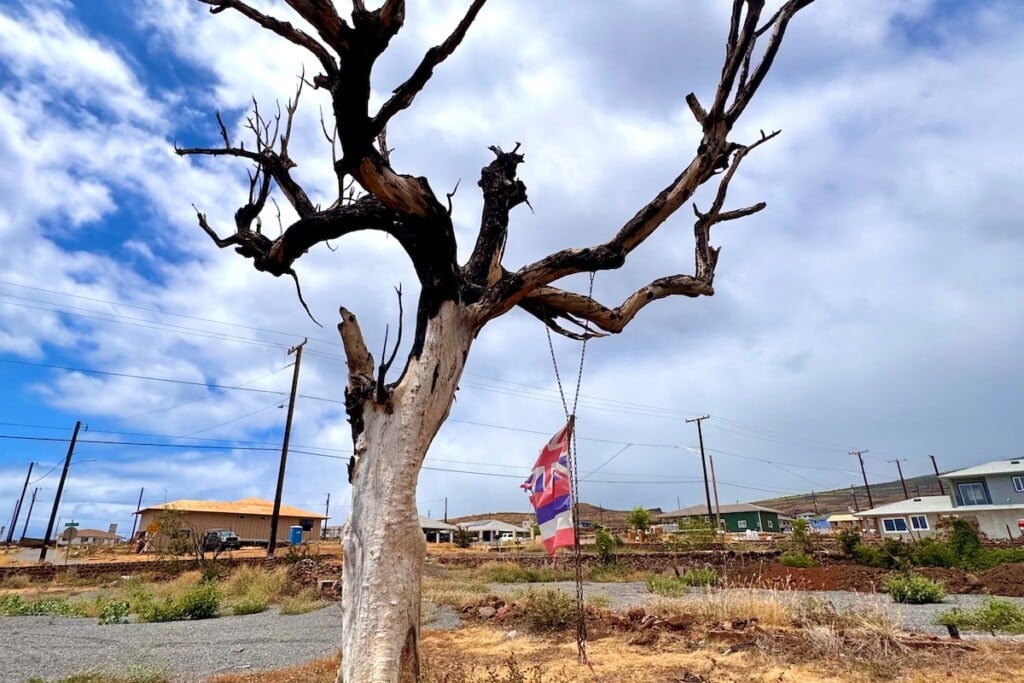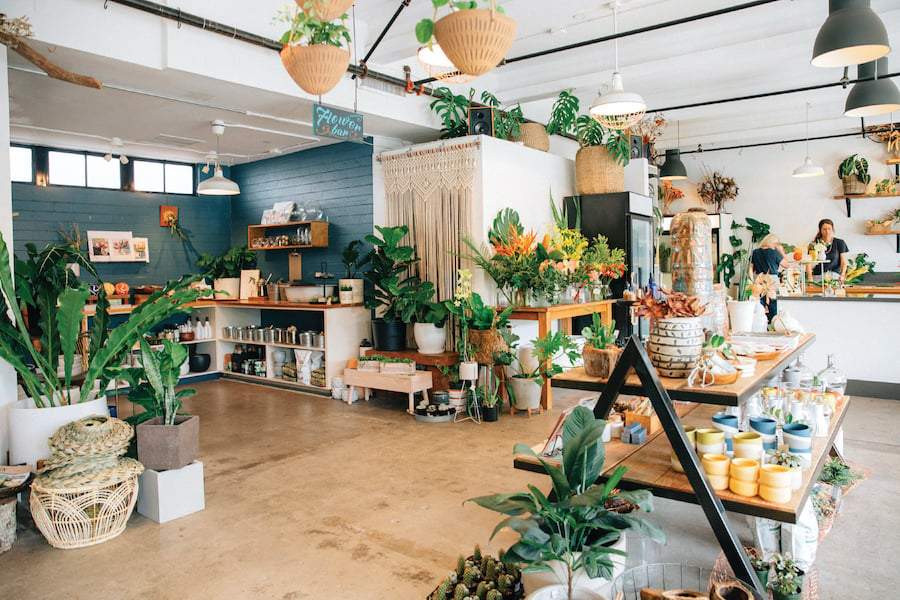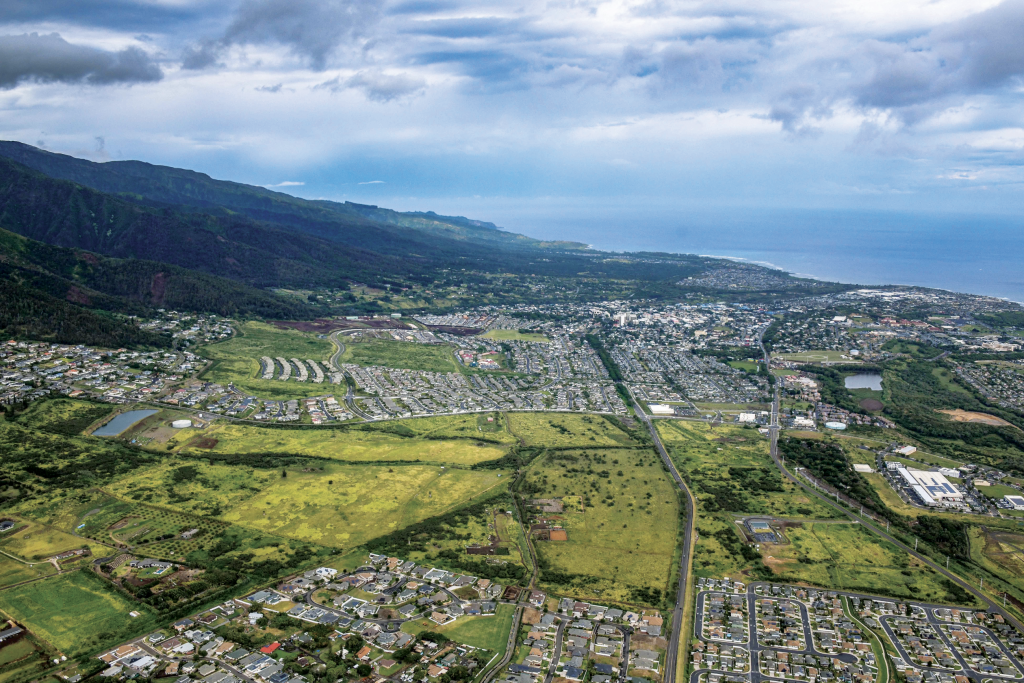Lahaina Is Rising, Slowly
Two years after the fire, its core historic and commercial center is still in ruins. But residents are rebuilding their businesses, homes and lives around the edges of town.

Lahaina – On Maui’s bustling west side, life has returned to normal. Traffic is dense between Lahaina and Kapalua, with people flocking to hotels and businesses. The parking lot of the renovated Lahaina Cannery, about a mile north of the ruined harbor, is jammed with cars. In the hills mauka of the highway that hugs Maui’s leeward coast, new homes are rising on empty pockets of land.
But nothing is really normal here. Nearly two years after wildfires destroyed Lahaina’s central historic and commercial district and leveled neighborhoods stretching into the foothills of the West Maui Mountains, residents still struggle to find stable ground.
They’ve endured long months moving from couches to hotels to rentals while hanging on to work, scrambling to find child care and plowing through reams of applications for assistance and reimbursement. Through it all, the terrible memories of Aug. 8, 2023, still haunt the survivors.
“7,000 Stories”
“Everyone has a story,” says Wilmont Kahaialii, a Hawaiian cultural expert, teacher and musician who lost his home in the fire. “There are 7,000 different stories. Some of them are more dramatic than others, and some are more devastating than others.”
Here are a few of those stories, including a homeowner who was one of the first to rebuild, a small business owner who’s reopening after losing a Front Street store, a noted artist who kept his clientele but not his studio, the leader of a historic foundation who’s planning complicated restorations, and the management team of a resort that longs for more visitors.
They mostly live or work near the old historic and commercial district, the heart of town that’s played a central role for centuries – as the seat of the Hawaiian monarchy, as a provisioning port in the whaling era, as a hub through the missionary and sugar plantation eras, and in more recent years, as a tourist mecca.
“In all my research, I cannot find another town in Hawai‘i that was a significant place during every era of Hawai‘i’s history,” says Theo Morrison, executive director of the Lahaina Restoration Foundation. Waves of people and commerce have shaped this small stretch of land that borders the protected harbor, a point of contact with the world beyond.
And in 2023, Lahaina entered a new chapter in its history: the fire era.
The Historic District
Historic Lahaina is still largely a ghost town.
Much of the district is charred and gray, with patches of gravel marking spots where structures once stood. Remnants of buildings poke up through the rubble like broken teeth in need of pulling.

Handmade street sign by Ke‘eaumoku Kapu | A stone marks the Hawaiian sacred site of Moku‘ula | Photography: Jeff Sanner
On a visit in mid-May, only a few vehicles traveled the vacant streets, including patrol cars. Occasionally, a fully intact structure came into view, a reminder of the zigzagging path of the fire, which ultimately destroyed about 2,200 structures.
The unscathed Maria Lanakila Catholic Church, for example, on the corner of Dickenson and Waine‘e streets, was open, with people milling about – a tiny pocket of normalcy amid the rubble.
South of the church and on the waterline is the stately seven-story Lahaina Shores condominium, which stands uneasily next to the bare foundations of neighboring properties. In late May, four of its studios were listed for sale at prices from $410,000 to $650,000, and vacation rentals were expected to restart this summer.
The main Front Street shoreline had recently been cleared of 237 concrete pilings and metal beams and bolts, and on Memorial Day weekend, the harbor area was opened to surfers. At the start of June, construction was scheduled to begin on a new project to replace the railing and sidewalk along Front Street.
Thick coral-block walls of many of the 19th-century buildings – “the anchors of town,” says Morrison – are still standing throughout the district: at the Old Lahaina Prison, built to hold rowdy sailors stopping over on whaling expeditions; at the Seamen’s Hospital on Front Street; at the Baldwin Home, the compound of the Rev. Dwight Baldwin and his large family, and once the oldest existing home on Maui.
All of these historic structures, and others that were gravely damaged or destroyed, will be fully restored or rebuilt, says Morrison. Artifacts have been recovered and debris removed from the 13 sites in the Lahaina Restoration Foundation’s care. A draft reconstruction plan, based on detailed drawings housed at the National Archives in Washington, D.C., has been finished.
The next step is to decide which projects to start first. About 90% of the restoration funds will come from a grant from the Federal Emergency Management Agency, and the rest from county grants, private philanthropy and other sources, Morrison says. While the Lahaina Long-Term Recovery Plan, released by the county in December 2024, estimates the restoration of historic structures will take at least six years, Morrison expects it to be completed much sooner.
The plan also calls for reviving Hawaiian cultural sites along the shore. Known collectively as the royal complex, the sites include the island of Moku‘ula, where King Kamehameha III lived from 1837 to 1845. The island was surrounded by a huge pond called Loko o Mokuhinia, long considered a sacred site. By the early 20th century, the pond had been filled with dirt and turned into a park.
The Golden Mile
On Aug. 7, 2023, Lahaina’s main shoreline strip around Front Street was packed with restaurants, bars, art galleries and museums, local jewelry stores and mainland clothing chains. Boats ferried visitors on snorkeling and fishing excursions, and oceanfront vacation rentals delivered the drama of a Maui sunset.
The next day, all of that was gone, along with about $70 million a month in revenue and 8,500 jobs, according to a UH Economic Research Organization report. The state Department of Business, Economic Development & Tourism put the number of shuttered businesses at 834.
And it’s still gone as rebuilding on Front Street has stalled, and the question of what can be built at the waterline is being hotly contested. But there are stirrings of revival, thanks in part to two recent rule changes enacted to kick-start both residential and commercial rebuilding.
The first, most significant measure altered the permitting process to make it much easier for property owners mauka of Front Street, or outside the erosion zone, to rebuild. Before the change in February, owners had to go through a lengthy, complicated process to get what’s known as a Special Management Area building permit.
Maui County officials estimated that relaxing the SMA rule would help 103 commercial and 533 residential structures get permits a full year faster than before.
The second change was an update to Ordinance 5780 of the county code. As of March 24, owners of “nonconforming structures” – those legally constructed before the wildfires but not compliant with current zoning standards, such as setback rules — can get permits to build similar structures.
By late May, the county saw a sudden jump in the number of nonresidential permits submitted for processing: 152 of them – for both commercial properties and housing with four units or more – were being processed, according to the county’s rebuilding dashboard. Before that, only 16 nonresidential permits had been issued and nothing had been built.
Residential permitting was even higher: 180 permits were being processed, 396 permits had been issued, 265 houses were under construction, and 23 homes were completed. About two dozen of the residential permits are for projects in the historic core of town, says John Smith, administrator of the county’s Office of Recovery.
Maui County’s Department of Finance found that, based on mailing addresses, only seven sales of wildfire-destroyed properties were made to out-of-state buyers, according to an email from the county’s Office of the Mayor.
Smith says relaxing the SMA rules was the main reason for the bump, as it “provided a level of certainty that allowed people to move forward.” He notes that even though SMA permits are waived, owners still have to follow design guidelines set by the historic district zoning code.
The Lahaina Front Street Recovery group, made up of 73 landowners, helped advocate for the rule changes, with the goal of bringing the old town back to what it was before the fire.
“The property owners on Front Street, almost unanimously I would say, want to rebuild what they had. Nobody’s talking about skyscrapers, nobody’s talking about Disneyland. Nobody wants to do any of that,” says Morrison.
Kaleo Schneider, who leads the Front Street coalition, agrees. “Lahaina was its own island unto itself,” she says. “It was beautiful, kitschy, fun, exciting, busy, and you could shop and mosey around. It looked like it had been there for a long time, and no one I’ve met doesn’t want to re-create it as it was before.”
She’d also like to see the commercial waterfront rebuilt, and has skin in the game. Schneider is president of an old kama‘āina business that owns five of the nine parcels on the makai side of Front Street, as well as the commercial buildings there. All but one of her buildings were destroyed in the fire.
The Lahaina Front Street Recovery group is pushing to rebuild “steadily and without friction,” she says, noting that 95% of the land and commercial property along both sides of Front Street are locally owned, even if lessees were mainland chains.
Schneider fears that adding delays and onerous rules to rebuilding the shoreline can create loopholes that mainland corporations could exploit. Delays might also make the commercial properties that trickle onto the market extremely valuable, she says, and far out of reach for local companies wanting to lease space.
This makai area still needs Special Management Area permits, which require an extensive review. Some landmark establishments that extended over the water have leases with the state Department of Land and Natural Resources, though whether those will be renewed is unclear. And the county is now trying to purchase other parcels of land on the makai side.
For the mostly commercial properties that could be turned into public spaces, the county’s Office of Recovery has sent letters of interest to see if owners would sell, says Smith, and a few transactions are underway. For private houses on the waterline, he says his office is helping owners navigate the SMA permitting process.
“We heard through conversations with the community that there was interest in having additional ocean access throughout Front Street,” says Smith, which motivated county efforts to buy property.
But some Lahaina residents would like more of the shoreline to remain open as a public space and a buffer from rising seas and storm surge.
“It’s an interesting chess match,” says Kahaialii. “You’ve got people who can afford the lawyers versus the county, who really can’t.” He hopes the county can get landowners to concede that the shoreline is an inundation zone and shouldn’t be redeveloped.
“It should never have been permitted, but it was,” he says.
Hope and Hardship for Businesses
While the historic core languishes, much of Lahaina’s commerce has moved to the edges of the burn zone. But the loss of Front Street – with its steady foot traffic and well-known sights – can make the transition hard.

Maui artist Ronaldo Macedo had to move his studio into a bedroom at his Puamana townhouse, which survived the fire. He’s holding a giclée print of Front Street; macedofineart.com | Photography: Jeff Sanner
For Ronaldo Macedo, one of Lahaina’s most successful artists, known for his street and harbor scenes, the loss can mean painting a place that no longer exists, based on memories and photos. He’s lately turned to painting the area’s scenic shorelines.
Macedo says he’s burdened with survivor’s guilt but considers himself lucky. His coastal townhouse at Puamana, at the southern edge of Lahaina, was spared. Ninety-five of the complex’s 230 homes were not.
He and his family were some of the first residents to return, just seven months after the fire. But their unit had been covered in ash that left a sticky sludge on everything, explains his wife, Jennifer Macedo, and they spent months cleaning it up before moving in. She describes the quiet, solitary nights back then as eerie and unsettling.
In February 2024, just as he was moving back home, Macedo was ejected from his large studio in Emerald Plaza to make way for a bicycle store willing to pay many times more in rent. He moved all of his inventory and painting and framing supplies to a small bedroom in his townhouse.
“I can keep working and selling, which is great, but there’s no more space in Lahaina to rent,” he says. “There’s lots of demand and no supply.”
In a stroke of luck, his primary gallery, Lahaina Galleries, had relocated in 2020 from its pricey Front Street location to a smaller, less expensive spot at The Shops at Wailea in Kīhei. The Kīhei location remains open, but dozens of galleries located in Lahaina’s historic district are now gone.
Macedo has held on to a roster of clients who pay well for his work, but he says the fire took a toll on his outlook and ability to work. It was a year before he could paint again.

Lopaka Wilson by his new store at Lahaina Cannery, expected to open this summer; he and his wife lost their Front Street location | A new Bank of Hawai‘i and the Cannery’s updated food court | Photography: Jeff Sanner
West Maui Sports and Fishing Supply sold ocean gear from a central Front Street shop for decades. In 2022, Lopaka and Katie Wilson bought the business, complete with an old cash register and pen-and-paper records.
The next year they lost everything, including the records they needed to receive fire-relief funds, which poured in from federal and state agencies, nonprofit organizations and private donations.
While they got some insurance money, the couple is “still fighting the insurance companies for loss of income,” says Lopaka Wilson. They were also offered a loan from the Small Business Administration but declined, since they’re still paying off a COVID-era loan.
To survive, the couple opened an online store while they searched for a brick-and-mortar location.
“We couldn’t find a place to rent,” says Lopaka Wilson. “We put in 20 different offers in different places and got shot down.” The competition was fierce as everyone was searching, he says, including doctors and banks. “As a small business, we were on the bottom of the list.”
Finally, in late 2024, they landed a temporary store at the Ka‘anapali Shores Hotel north of Lahaina, where there’s some visitor business but few local customers. “It’s just nice to be open and operating. It’s like a glimpse of hope,” he says.
The Wilsons also signed a lease in May 2024 on a permanent store at the Lahaina Cannery, just north of the burn zone on Front Street. They’re still waiting for a permit to build out the store’s interior and hope to be open this summer.
With two locations, the Wilsons are shouldering an unnerving amount of risk. “Actually, my house is on the line for this spot at the Cannery,” says Lopaka Wilson. “If this doesn’t work out, I’ll be hopping around.”
Many businesses are putting their hopes in this shopping center near the ocean, which serves as a gathering spot and event space, and in the commercial centers mauka of Highway 30. Its anchor stores, Safeway and Longs, reopened shortly after the fire and helped keep survivors afloat.
Storefronts of open shops and coming-soon signs line the Cannery’s interior spaces. In the airy, air-conditioned food court, new food trucks are serving customers, and a new Bank of Hawai‘i branch recently opened in the parking lot outside, replacing the one that was destroyed.

Tara-Lynn Kahaialii Diego’s Kahoma Village townhome near Baby Beach survived the fire but had heavy smoke damage | Photography: Jeff Sanner
Finding a Stable Home
Ann Williams barely escaped the wildfire that raced along Lahainaluna Road and destroyed nearly everything in its path.
Her own house, about halfway up the hill, burned to the ground. Forty of the 102 people known to have died in the wildfire lived in the cramped Kuhua Camp area, just down the road.

Ann Williams’ home on Lahainaluna Road was destroyed by fire; her new house is one of the first to be completed | Photography: Jeff Sanner
Williams, a real estate agent with Keller Williams Realty Maui, fled to a friend’s house, then rented a small apartment in Ka‘anapali. When her daughter moved with her family to a FEMA-organized house in Kula, Williams decided to move too.
“I didn’t want to be there alone,” she says. “My granddaughter and my daughter – that’s my whole family right there.”
She was paying the mortgage on her ruined house and insurance covered much of the rebuilding, which she’s completed in stages. But getting that insurance, she says, was “a fight, every little step of the way.”
In May, the charming, cozy house with an expansive back lānai was nearly done. Electricity, water and sewage are working in the area, but Williams’ old mango, citrus and avocado trees are gone, leaving the place exposed and hot.
Williams is anxious about moving in and says she’ll probably rent out the house until the semblance of a neighborhood emerges. The streets still feel like a wasteland, though intact houses and new construction dot the landscape.
Across from her house, a mammoth two-story home has been framed and roofed. Beyond that, in the hills, severe drought has dried out the wild grasses, the very fuel that threw all of their lives into chaos.
Among the many fire-mitigation efforts underway, Hawaiian Electric is installing high-resolution cameras that monitor fire-prone areas and send data directly to Maui fire stations.
Back near the shoreline, Tara-Lynn Kahaialii Diego says it was “bittersweet” to finally come home in January. She was one of the last owners to return to Kahoma Village, near the entrance to Pu‘unoa, or Baby Beach.
While most of the townhouses in Kahoma Village survived, four buildings did not; the homeowners association hired an attorney to get a Special Management Area permit to rebuild them before the rules were relaxed. Across the street, Diego’s former affordable rental complex is gone.
In the 17 months between the fire and her return, Diego bounced among her husband’s family in Hāna, a condo and a hotel offered through the Red Cross relocation program, then on to Kīhei, with other stops along the way.
Through all of that, along with dealing with ceaseless paperwork for temporary housing, financial assistance and child care for their young daughter, she and her husband were able to keep their clothing business – Unconquered Hawaii – alive through pop-up events.
And there were other complications. She was diagnosed with cancer and underwent two surgeries and six months of treatment. “I can only handle one thing at a time mentally,” she says. “I wanted to be done with my treatment, but I also wanted the debris gone.”
In addition to all the debris, her home had severe ash and smoke damage. She gutted the unit’s interior and, worried about toxins, threw away most of her family’s possessions.
“Now I’m just so glad to be back,” says Diego. “A big part of it is the connections, seeing the people, seeing businesses come back that went away.”

After losing his home, Wilmont Kahaialii and his family moved from place to place before securing a futurist temporary home at Ka La‘i Ola | Photography: Jeff Sanner
Life in “The Fishbowls”
Far up in the hills above Lahaina, where the ruined subdivisions along Wahikuli Road meet the bare, red-dirt Mars-scape of the West Maui Mountains, Wilmont Kahaialii lives with his wife and two sons in glass-lined pods.
“It’s kind of like I get to live in ‘The Jetsons’ house,” he says with a laugh, referring to the futuristic 1960s cartoon.
After the fire destroyed their home, Kahaialii and his family spent six months at a friend’s house, then about a year in a home that FEMA found for them in Kīhei. In March, they landed a place to live at Ka La‘i Ola, a collection of temporary homes, which he says some residents affectionately call “the fishbowls.” The more traditional tiny houses there are known as “the chicken coops.”
The development is a huge undertaking for local nonprofits HomeAid Hawai‘i and the Hawai‘i Community Foundation, and will include 450 units on 57 acres when completed.
Kahaialii’s unit has nearly 600 square feet of space, with three bedrooms and two bathrooms. He says one of his sons is so tall that “he’s walking with a hunch” in their new home, made up of two adjoining pods produced by the Hawai‘i-founded company NanoNest.
But it’s comfortable too, with air conditioning, a small lānai and garden, community picnic areas and sweeping views of the ocean. He says his wife is happy there.
Starting in August, rent will be based on household income, he says. His family plans to stay at Ka La‘i Ola until their lease is up, which he says is in three years. After that, he hopes to finally get off the Hawaiian Home Lands waitlist, which he’s been on for 28 years.
Though Kahaialii likes to laugh and tell jokes, there’s a seriousness beneath his lighthearted demeanor when he says that if the 30-year mark comes with no homestead lease, “I’m going to start a revolution.”
The Sound of Hammers
These stories of displacement match survey data collected by UHERO and reported in the Hawai‘i Housing Factbook 2025: The tumult of moving from place to place has slowed, but people remain vulnerable.
About three-quarters of respondents said they had stayed in one place for at least six months, a measure of stability. But the report noted that “displacement remains a significant risk” given that half of the respondents were in temporary housing of some sort, such as staying with friends and family.

By early June, 180 residential permits were being processed, 396 permits had been issued, 265 houses were under construction, and 23 homes were completed | Photography: Jeff Sanner
When those arrangements fall apart, more trouble can await in the form of low inventory and high prices. Median rental costs for small one- and two-bedroom units have inched down since the fire, but the median rent in Lahaina is still $2,099 and the median asking rent on Craigslist is $3,300, according to UHERO’s Factbook.
More than half of renters in Lahaina pay over 30% of their income for rent, and a quarter pay more than 50%; the latter is considered severely rent burdened. The median rental price in Maui County as a whole is about $250 cheaper than in Lahaina, and asking prices are $750 less.
Buying real estate is even tougher. The median price for a single-family home in Lahaina is an eye-popping $1,697,500, about half a million dollars more than the county’s median price. The median price for condos is $975,000, more than $62,000 higher than in Maui County overall.
“All of Maui is ridiculous right now. A lot of people I know tell me they can’t pay Lahaina prices, and can barely afford Kīhei,” says Diego. “People are still commuting from other parts of the island for work. You do whatever you have to do to make it work right now.”
One proposal moving through the Maui County Council is to phase out about 6,000 of the island’s nearly 11,000 short-term vacation rentals. These condo units are on 2001’s so-called Minatoya list of properties that are allowed to operate as short-term rentals.
Many owners won’t be happy if their units are phased out, and even some residents are skeptical it would help much. “Just taking them away from the visitor industry does not make it more affordable to live here,” says Diego. “It’s a step in the right direction, but we still need more, whether it’s rental caps or something else.”
Some people are taking matters into their own hands and erecting houses without permits. Smith, from the county Office of Recovery, says the government actively pursues such violations with stop-work notices to “make the owner or contractor come into compliance. That has happened a few times, but it’s not pervasive,” he says.
In other cases, the huge homes emerging on plots where single-story houses once stood are actually legal. “What I think people are a little shocked by is what the zoning code allows,” Smith says, including homes up to 30 feet tall.
These new, bigger houses are often better suited for Lahaina’s multigenerational households than the old, tiny cottages with rooms that are added on later, explains Erin Wade, Maui County’s deputy managing director.
“Folks are coming in and making a big investment [in rebuilding], and it’s often a two-story house that now has a garage, which it didn’t before,” she says. “I think the proportionality is surprising for people.”
With the rising number of permits and new construction in progress, Laksmi Abraham, the director of communications and government affairs in the mayor’s office, says Lahaina is “at a critical tipping point” in its transformation.
“When you walk through the neighborhoods where they’re rebuilding, you hear the hammers and the heavy machinery. It’s so encouraging, there’s so much hope.”
More Visitors, Please
Travel just a couple of miles north of the burn zone, and the landscape dramatically changes to lush vegetation and long, golden beaches. This manicured, well-watered stretch of the arid coast is as calming as the advertisements promise. It’s also a sore spot among residents who are frequently asked to conserve water.
At the Royal Lahaina Resort & Bungalows, wind flows from the ocean through the open lobby. Yachts are anchored in the ‘Au‘au Channel that separates Maui and Lāna‘i, a handful of visitors sunbathe by the pool and guests browse in the newly opened Mana Up boutique.

The management team at the Royal Lahaina Resort & Bungalows, Duane Sparkman, left, Yvette Kitagawa and Nicholas Kuhns. At left, a Mana Up store just opened at the resort. | Photography: Jeff Sanner
The resort reopened to tourism in June 2024, after 10 months of hosting fire survivors. Yvette Kitagawa, the hotel manager, says at least 1,500 survivors stayed at the resort.
“Two days after the fire, we put people up, and with no contracts yet from the Red Cross or FEMA. No one was vetted, so it was nerve-wracking,” Kitagawa says.
She says she told her staff, “I want everyone talking to people and making them feel at home.” In turn, the new guests treated their rooms well, like their own homes, she says, and the resort encountered very few problems.
Now tourists are back but business remains slow, at about 50% occupancy, says Nicholas Kuhns, general manager of Royal Lahaina Resort & Bungalows. Group travel is down, Japanese visitor numbers remain depressed, and many Canadian tourists are boycotting the U.S. after President Donald Trump imposed tariffs and threatened a national takeover.
And for travelers to Hawai‘i, the warnings to stay away from Maui that circulated shortly after the fire may have stuck. In the first three months of 2025, the island of Maui had 58,574 visitors, compared with 65,287 in 2022, a 10% drop. Other islands saw increases.
“Three out of four dollars on Maui come from tourism,” says Kuhns. The businesses that are open in West Maui need visitors, he says, and the people living there want to get back to work.
The Lost Trees
On the outskirts of the Royal Lahaina Resort’s large property is a collection of trees growing in pots. When they’re sturdy enough to plant in the ground, they’ll be given free to residents who want to replace their fire-ruined trees.
The project is the brainchild of Duane Sparkman, the resort’s chief engineer and the founder and president of Treecovery Hawaii. He estimates that 21,000 trees burned and 24,000 need to be planted.
So far, 14 resorts as well as the Kahului Airport and other places have devoted space on their properties for the trees, which were purchased through donations. About 6,000 have been planted, including ‘ulu, persimmon, fig and coconut trees.
“We live in two worlds – the corporate world and the cultural world,” says Sparkman. “This project brings them together. It’s healing so many people in so many ways.”
One of his most visible tree-saving projects is also the most emotionally fraught: the old banyan tree on Front Street, planted in 1873. The tree once stood 60 feet tall and covered two-thirds of an acre.
After being scorched in the fire, the only living tissues were found in the lower trunks, and the tree’s fate was uncertain. Arborists and volunteers kept the tree alive, and while it’s still fragile, it’s growing.
The Lahaina Restoration Foundation oversees the park where the tree lives. Morrison, the group’s executive director, says the Treecovery team is using an air-layering technique to create “baby banyans,” which are cared for in pots. When the grafted branches are planted in the ground, they’ll grow upward and join the original tree.
Like everything about Lahaina two years after the fire, the banyan tree’s recovery is an inspiring story of resilience, but also frustratingly slow and tentative – and triggers so much pathos it brings tears to the eyes. If the tree had a message for the town, it might be to keep moving forward, branch by branch, building by building.
“You have to have hope that we can rebuild,” says Morrison. “It’s slower than people want it to be, of course, but we’re a real strong community and we will rebuild. You just can’t really sit down and think about it too much. You’ve just got to keep going.”
Rebecca Brooking helped in the reporting of this article.
Remembering Lahaina: Places, People & Culture
Special thanks to Maui artists Ronaldo Macedo, Carleton and Macario Pascual for granting permission to use images of their paintings in this story. The paintings are included in Remembering Lahaina, a large-format art book produced by the Maui Arts League and Legacy Isle Publishing.
The book gathers 251 original paintings from 87 artists worldwide, all of which were created during Maui Plein Air Painting Invitational events. The
term “plein air” comes from a French phrase for “outdoors.”
Net proceeds from sales of the first release of Remembering Lahaina will benefit Maui artists and their staff who were affected by the August 8, 2023, wildfires.
To order a copy, visit Legacy Isle Publishing or the Maui Arts League store.










